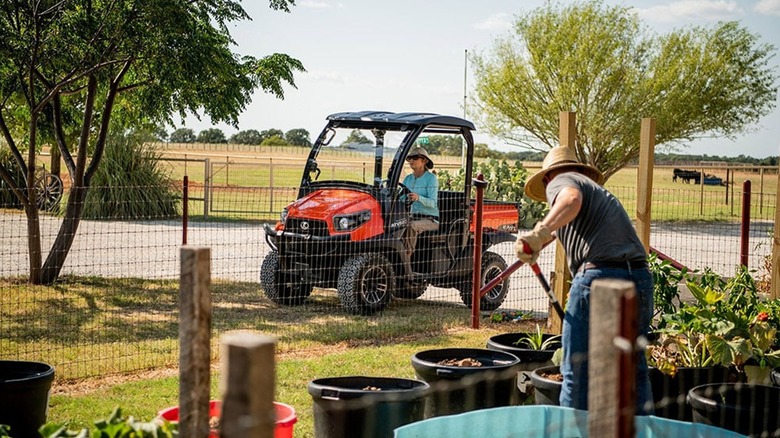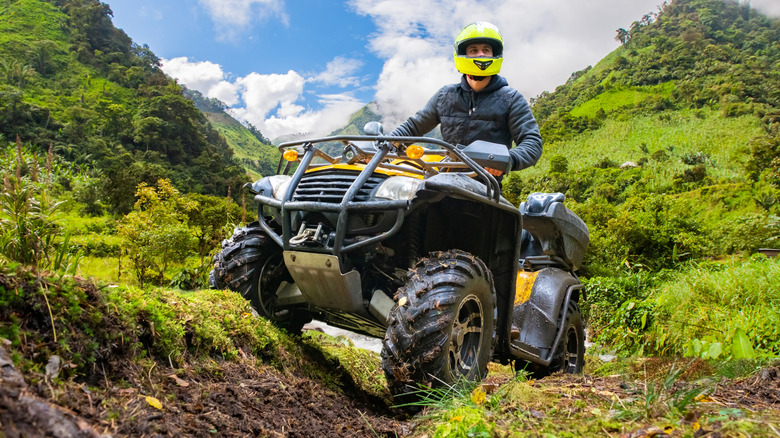What Is An RTV Vehicle, And How Is It Different Than An ATV?
When it comes to vehicles that can handle rough and uneven dirt roads, we're pretty spoiled for choices. Even putting aside full-sized off-roading cars like Jeeps, there are plenty of smaller vehicles that fit the same niche. The most prominent examples of these kinds of vehicles are ATVs and UTVs, which can be ridden for both work and pleasure purposes. ATVs in particular are quite fun, with offerings from brands like Yamaha featuring exceptionally sleek designs. However, ATVs and UTVs aren't the only vehicles on rugged pathways of the world, and we're not talking about three-wheeled all-terrain cycles. There's another option available with a similarly abbreviated name: RTVs.
Considering ATVs and UTVs already occupy the majority of the off-roading niche, you might wonder what the purpose is of yet another off-roading vehicle, and what even differentiates it from its contemporaries. Compared to the headliners, RTVs do have a lot of similarities, but also a few major distinctions that may make them better suited for certain kinds of roads and tasks. There are definitely a few drives you could make with an ATV if you already have one, but depending on what you plan on using it for, an RTV may be the better option.
RTV stands for rough terrain vehicle
The precise meaning of the RTV acronym may differ slightly depending on who you ask, but generally, it stands for either "rough terrain vehicle" or "rugged terrain vehicle." RTVs, as a concept, were actually created by the Japanese utility vehicle brand Kubota as a sort of spin-off of the existing ideas of UTVs.
The design is similar; it's a small motorized vehicle, roughly the size of a large golf cart, equipped with grippy, all-terrain tires. RTVs may also include features like mud and water-repelling side flaps or solid doors for entry, additional passenger seating, and rear beds for hauling stuff.
What differentiates an RTV primarily from a UTV is that where UTVs can be put toward leisure or work purposes, RTVs are almost exclusively work vehicles and have features that reflect that. These are not vehicles you're supposed to be racing with — they're for hauling people and cargo around on large jobsites and farms, and doing so safely. This is why RTVs have a greater emphasis on safety with built-in seatbelts and more comfortable seats. Basically, where a UTV is a souped-up golf cart, an RTV is more like a small truck.
An ATV is like a bike, while an RTV is like a car
We've already covered what differentiates RTVs from UTVs, but what about ATVs? Since "ATV" stands for "all-terrain vehicle," you may assume that one could handle the same kinds of roads that an RTV could. Perhaps, but it's less about which roads they handle and more about how they handle them.
An ATV is more like a motorcycle, given its saddle-style seat and handlebar. This is a vehicle that you're meant to have fun with and feel the wind in your face. An RTV, meanwhile, is more like a car in its operation, with a traditional steering wheel and pedals.
RTVs are also more muscular than ATVs, generally speaking. An ATV could probably do some jobsite hauling if it were sufficiently powerful and had a small trailer hitched up to it, but this would be a secondary purpose. An RTV is intended for that kind of transportation first and foremost. They have stronger engines and more robust bodies that can carry and tow large, heavy loads that an ATV might not be able to handle.


